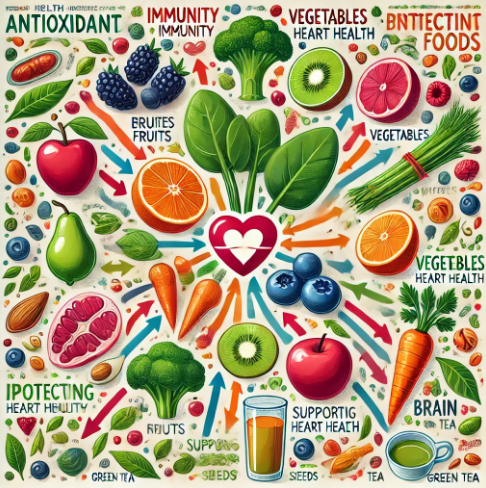Introduction: What Are Antioxidants and Why Do We Need Them?
Antioxidants are compounds found in certain foods that play a vital role in protecting our bodies from oxidative stress and damage caused by free radicals. Free radicals are unstable molecules that can harm cells, leading to chronic diseases such as cancer, heart disease, and aging-related conditions. By neutralizing these free radicals, antioxidants help maintain overall health, strengthen the immune system, and promote longevity. In this article, we’ll dive into the types of antioxidants, their health benefits, and how to incorporate more antioxidant-rich foods into your diet.
Understanding Free Radicals and Oxidative Stress
- What Are Free Radicals? Free radicals are molecules with an unpaired electron, making them highly reactive and unstable. They are formed as a natural byproduct of metabolic processes, but factors like pollution, radiation, smoking, and an unhealthy diet can increase their production.
- The Danger of Oxidative Stress When free radicals accumulate faster than the body can neutralize them, it leads to oxidative stress. Over time, oxidative stress damages cells, proteins, and DNA, contributing to aging and the development of chronic diseases.
Types of Antioxidants and How They Work
- Vitamin C (Ascorbic Acid) One of the most well-known antioxidants, vitamin C, is essential for neutralizing free radicals and supporting the immune system. It is water-soluble and found in a wide variety of fruits and vegetables, including oranges, strawberries, bell peppers, and broccoli.
- Vitamin E (Tocopherol) Vitamin E is a fat-soluble antioxidant that protects cell membranes from oxidative damage. It’s found in nuts, seeds, spinach, and sunflower oil. Vitamin E is particularly important for skin health and protecting against UV damage.
- Beta-Carotene Beta-carotene is a type of carotenoid that the body converts into vitamin A, which is essential for vision, skin health, and immune function. It’s abundant in orange and yellow vegetables like carrots, sweet potatoes, and pumpkins.
- Selenium Selenium is a trace mineral with powerful antioxidant properties. It works with other antioxidants, such as vitamin E, to prevent cell damage. Foods rich in selenium include Brazil nuts, tuna, and whole grains.
- Flavonoids Flavonoids are a group of plant-based antioxidants found in fruits, vegetables, tea, and wine. They have anti-inflammatory and immune-boosting properties, with studies suggesting they can reduce the risk of heart disease and cancer.
Health Benefits of Antioxidants
- Protects Against Chronic Diseases Antioxidants help prevent chronic diseases by neutralizing free radicals, which contribute to conditions like cancer, heart disease, and diabetes. By reducing oxidative damage, antioxidants also slow down the aging process.
- Boosts Immune System Antioxidants, particularly vitamin C and flavonoids, play a key role in enhancing immune function. They protect immune cells from oxidative damage, helping the body fight infections more effectively.
- Promotes Skin Health Antioxidants protect the skin from environmental stressors like UV radiation and pollution. Vitamin C, E, and beta-carotene are especially beneficial for reducing the appearance of wrinkles, promoting collagen production, and maintaining skin elasticity.
- Supports Heart Health Antioxidants, such as flavonoids and vitamin E, are known for their heart-protective effects. They reduce inflammation, lower blood pressure, and improve blood vessel function, all of which reduce the risk of cardiovascular diseases.
- Improves Cognitive Function Antioxidants protect the brain from oxidative stress, which is linked to neurodegenerative diseases like Alzheimer’s and Parkinson’s. Consuming antioxidant-rich foods may improve memory and slow cognitive decline.
How to Incorporate More Antioxidants into Your Diet
- Eat a Rainbow of Fruits and Vegetables The more colorful your plate, the more antioxidants you’re likely to consume. Aim to eat a variety of fruits and vegetables in different colors, such as berries, citrus fruits, leafy greens, carrots, and bell peppers.
- Include Nuts and Seeds Nuts and seeds, such as almonds, sunflower seeds, and flaxseeds, are excellent sources of antioxidants like vitamin E and selenium. They make for a perfect snack or topping for salads and yogurt.
- Drink Green Tea Green tea is rich in catechins, a type of flavonoid with potent antioxidant properties. Drinking green tea regularly may reduce inflammation, lower the risk of heart disease, and improve brain function.
- Enjoy Dark Chocolate Dark chocolate contains flavonoids that have been shown to improve heart health by lowering blood pressure and increasing blood flow. Choose chocolate with at least 70% cocoa for the most antioxidant benefits.
- Add Herbs and Spices Many herbs and spices are loaded with antioxidants. Turmeric, cinnamon, ginger, and oregano are all high in antioxidants and can be easily added to meals for an extra health boost.
- Choose Whole Grains Whole grains, such as brown rice, quinoa, and oats, contain antioxidants like selenium and phenolic acids. Swapping refined grains for whole grains can increase your antioxidant intake.
Conclusion: Embrace Antioxidant-Rich Foods for Better Health
Antioxidants are a crucial part of a healthy diet that can protect your body from oxidative damage and reduce the risk of many chronic diseases. By incorporating a wide variety of antioxidant-rich foods into your daily meals, you can promote better health, boost your immune system, and support long-term well-being. Simple changes, such as eating more colorful fruits and vegetables, enjoying green tea, and adding nuts and seeds to your diet, can make a big difference in how you feel and function.
Sources:
- Packer, L., and Fuchs, J. “Antioxidant in Disease Mechanisms and Therapy.” Marcel Dekker Inc., 1993.
- Halliwell, B., and Gutteridge, J. M. C. “Free Radicals in Biology and Medicine.” Oxford University Press, 2015.
- Frei, B. “Natural Antioxidants in Human Health and Disease.” Academic Press, 1994.
- Ames, B. N., Shigenaga, M. K., and Hagen, T. M. “Oxidants, Antioxidants, and the Degenerative Diseases of Aging.” Proceedings of the National Academy of Sciences, vol. 90, no. 17, 1993, pp. 7915-7922.
- Harman, D. “The Free Radical Theory of Aging.” Antioxidants & Redox Signaling, vol. 5, no. 5, 2003, pp. 557-561.
